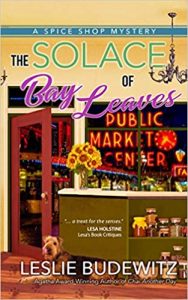Finding Emotional Connection
 by Leslie Budewitz
by Leslie Budewitz
We read for many reasons: To peek into a time or place that fascinates us. To catch up with old friends, or watch in disbelief as they go wild. To avoid dirty looks when we show up at book club with wine but without having read the book. To be entertained.
But above all, we read to connect. We connect with characters who aren’t anything like us. I haven’t got Lizzie Bennet’s four sisters, or Meg March’s three. I hope I am nothing like Olive Kitteridge. (The jury’s still out; I’m afraid we all have our inner Olive.) My life bears no resemblance to that of Asher Lev. Though I have read hundreds, maybe thousands, of mysteries and crime novels. I have never caught a killer, nor, thank heavens, been one. But I have connected with characters created by Deborah Crombie, Margaret Maron, Jacqueline Winspear, and Sujata Massey, and walked the mean and not-so-mean streets with Barbara Neely, Anne Perry, and Sara Paretsky, authors who take me places I have never been.
I love these authors because they show me what it’s like to live in their characters’ world, and in their skin and hearts.
Turns out, that’s why I write, too.
My tenth published novel, The Solace of Bay Leaves, is newly out, and I’ve just turned in edits on my eleventh, Bitterroot Lake. One is a cozy mystery, fifth in a series, and the other my suspense debut, but both explore fractures in women’s friendship. (Apparently my subconscious mind, the one that chooses what I write about, won’t give up a theme until it’s had its say.)
They share something else, too. In each, I hit a wall half-way through the first draft, forcing me to stop and revisit the main characters’ central emotional conflicts. Without it, I was simply moving people around on the page, to neither their satisfaction or my own. Once I found it, the scenes unfolded readily. Once I identified what was well and truly at stake for the protagonist—in her mind and her heart—it was almost easy to figure out what happened, and a lot more fun. Finding the emotion triggered the plot.
Not something you expected a mystery writer to say, is it?
We read, and write, for emotional experience. Among my own books, the strongest stories were driven by emotional conflict. It may be what connects sleuth to victim or accused, compelling her to investigate. (What my friend, retired editor Ramona DeFelice Long, calls the VGR, or “very good reason.”) Or a need so deep-seated that it’s visceral and leads to murder—for revenge, to protect a secret, or to wound someone who’s wounded them.
Years ago, I took an intensive workshop with mystery writer Elizabeth George. She’s highly process-driven, believing that strong process, and craft, create an opening for art. What, she asks, is each character’s core need—for approval, for action, to be right or competent. What is their “pathological maneuver”—what I see as their visceral response, their misconception, what they’ll do to get what they want, or when they don’t get it.
I’ve also attended workshops with Donald Maass, author of The Emotional Craft of Fiction and other books. (I highly recommend them all.) Don says we create an emotional experience for our readers not by describing an emotional experience our characters are having, but by evoking one in them. How on earth do we do that?
You got it: By creating a connection that allows the readers to draw on their own experiences to understand and share in what the characters are feeling.
To find that central emotional element, ask your subconscious. Be honest with yourself. Listen to the characters. While writing Solace, I knew the plot, or thought I did, and was surprised to discover that my protagonist, Pepper Reece, had gone all the way through school with the shooting victim, Maddie Petrosian. At the same time, I realized we were approaching the third anniversary of the murder of Patrick Halloran, the husband of Pepper’s friend Laurel. A murder still unsolved. Obviously, I had to solve it—and the two crimes were connected.
By paying attention, I realized this book wasn’t about that other stuff I’d thought was the plot. It was about women’s friendships. The jealousies and tensions that had derailed Pepper and Maddie’s friendship, and the threads that still connected them. How Pepper’s loyalty to Laurel drove her to investigate Patrick’s murder, despite her anger over learning Laurel had kept a critical secret from her. I thought about secrets and jealousies in my own life. About my own long friendships, what threats they’ve endured, and why others have ended. I asked how these emotions felt in my body, and what I might do if I were Pepper, or Laurel, or Maddie.
When we create an emotional experience for ourselves, creating it for our readers becomes a joy.
***
Leslie Budewitz blends her passion for food, great mysteries, and the Northwest in two cozy mystery series, the Spice Shop mysteries set in Seattle’s Pike Place Market, and the Food Lovers’ Village mysteries, set in NW Montana, where she lives. The Solace of Bay Leaves, the 5th Spice Shop mystery, is out now from Seventh Street Books.
“Readers attracted to unusual settings and mature, introspective amateur sleuths will appreciate this intricately plotted story depicting the impact of murder on the family and community.” – Library Journal, in a starred review
Her suspense debut, Bitterroot Lake, written as Alicia Beckman, will appear in April 2021. A three-time Agatha-Award winner, she is a past president of Sisters in Crime and a current board member of Mystery Writers of America. She lives in NW Montana.
www.Facebook.com/LeslieBudewitzAuthor
—
THE SOLACE OF BAY LEAVES
 “The character-driven mystery is darker than many cozies. Readers attracted to unusual settings and mature, introspective amateur sleuths will appreciate this intricately plotted story depicting the impact of murder on the family and community.
“The character-driven mystery is darker than many cozies. Readers attracted to unusual settings and mature, introspective amateur sleuths will appreciate this intricately plotted story depicting the impact of murder on the family and community.
— Library Journal Starred Review
A cozy and savory mystery blend of spices, murder and amateur sleuths in Seattle
Pepper Reece never expected to find solace in bay leaves.
But when her life fell apart at forty and she bought the venerable-but-rundown Spice Shop in Seattle’s Pike Place Market, her days took a tasty turn. Now she’s savoring the prospect of a flavorful fall and a busy holiday cooking season, until danger bubbles to the surface . . .
Between managing her shop, worrying about her staff, and navigating a delicious new relationship, Pepper’s firing on all burners. But when her childhood friend Maddie is shot and gravely wounded, the incident is quickly tied to an unsolved murder that left another close friend a widow.
Convinced that the secret to both crimes lies in the history of a once-beloved building, Pepper uses her local-girl contacts and her talent for asking questions to unearth startling links between the past and present—links that suggest her childhood friend may not have been the Golden Girl she appeared to be. Pepper is forced to face her own regrets and unsavory emotions, if she wants to save Maddie’s life—and her own.
Category: How To and Tips

























Thanks so much for giving me the opportunity to share a few thoughts with your readers.